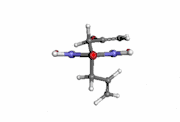Brallobarbital
 | |
 | |
| Clinical data | |
|---|---|
| Synonyms | Brallobarbital |
| ATC code |
|
| Identifiers | |
| |
| CAS Number | |
| PubChem CID | |
| ChemSpider | |
| UNII | |
| ChEMBL | |
| ECHA InfoCard |
100.008.387 |
| Chemical and physical data | |
| Formula | C10H11BrN2O3 |
| Molar mass | 287.110 g/mol |
| 3D model (JSmol) | |
| |
| |
| | |
Brallobarbital is a barbiturate developed in the 1920s.[1] It has sedative and hypnotic properties, and was used for the treatment of insomnia. Brallobarbital was primarily sold as part of a combination product called Vesparax, composed of 150 mg secobarbital, 50 mg brallobarbital and 50 mg hydroxyzine.[2] The long half-life of this combination of drugs tended to cause a hangover effect the next day,[3] and Vesparax fell into disuse once newer drugs with lesser side effects had been developed.[4]
References
- ↑ US Patent 1869666
- ↑ Lhermann J. Clinical application of a new very active hypnotic associating sodium secobarbital, calcium brallobarbital and hydroxyzine (UC-8130). Gazette Medicale de France. 1964 Mar 10;71:961-2. (French)
- ↑ Yih, T. D.; Van Rossum, J. M. (30 September 2009). "Peculiar Pharmacokinetics of Brallobarbital as a Source of Complications in Vesparax® Intoxication". Xenobiotica. 6 (6): 355–362. doi:10.3109/00498257609151647.
- ↑ Fischbach, R (February 1983). "Efficacy and safety of midazolam and vesparax in treatment of sleep disorders". British Journal of Clinical Pharmacology. 16 (S1): 167S–171S. doi:10.1111/j.1365-2125.1983.tb02290.x. PMC 1428085.
This article is issued from
Wikipedia.
The text is licensed under Creative Commons - Attribution - Sharealike.
Additional terms may apply for the media files.